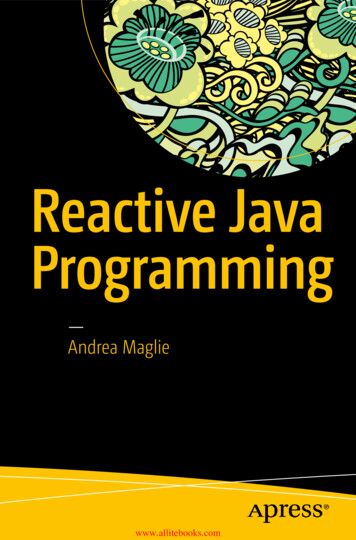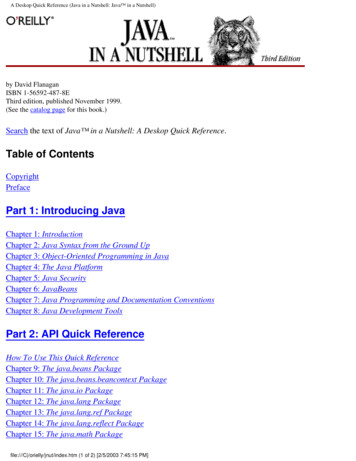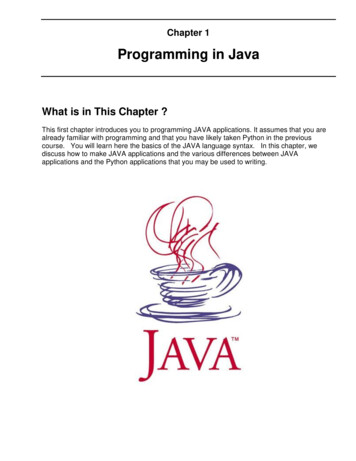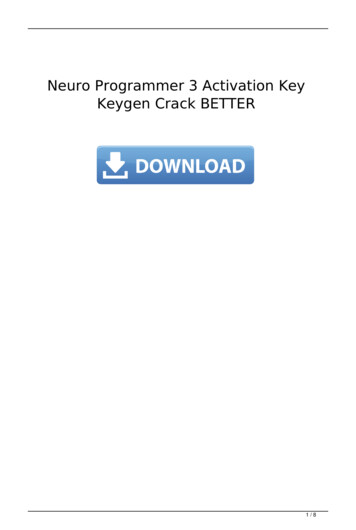
Transcription
Reactive JavaProgramming—Andrea Magliewww.allitebooks.com
Reactive JavaProgrammingAndrea Magliewww.allitebooks.com
Reactive Java ProgrammingAndrea MaglieVenice, ItalyISBN-13 (pbk): 978-1-4842-1429-9DOI 10.1007/978-1-4842-1428-2ISBN-13 (electronic): 978-1-4842-1428-2Library of Congress Control Number: 2016957883Copyright 2016 by Andrea MaglieThis work is subject to copyright. All rights are reserved by the Publisher, whether the wholeor part of the material is concerned, specifically the rights of translation, reprinting, reuse ofillustrations, recitation, broadcasting, reproduction on microfilms or in any other physicalway, and transmission or information storage and retrieval, electronic adaptation, computersoftware, or by similar or dissimilar methodology now known or hereafter developed.Trademarked names, logos, and images may appear in this book. Rather than use a trademarksymbol with every occurrence of a trademarked name, logo, or image we use the names, logos,and images only in an editorial fashion and to the benefit of the trademark owner, with nointention of infringement of the trademark.The use in this publication of trade names, trademarks, service marks, and similar terms, evenif they are not identified as such, is not to be taken as an expression of opinion as to whether ornot they are subject to proprietary rights.While the advice and information in this book are believed to be true and accurate at thedate of publication, neither the authors nor the editors nor the publisher can accept any legalresponsibility for any errors or omissions that may be made. The publisher makes no warranty,express or implied, with respect to the material contained herein.Managing Director: Welmoed SpahrLead Editor: Steve AnglinTechnical Reviewer: Manuel Jordan EleraEditorial Board: Steve Anglin, Pramila Balan, Laura Berendson, Aaron Black,Louise Corrigan, Jonathan Gennick, Robert Hutchinson, Celestin Suresh John, NikhilKarkal, James Markham, Susan McDermott, Matthew Moodie, Natalie Pao, GwenanSpearingCoordinating Editor: Mark PowersCopy Editor: Mary BehrCompositor: SPi GlobalIndexer: SPi GlobalArtist: SPi GlobalDistributed to the book trade worldwide by Springer Science Business Media New York,233 Spring Street, 6th Floor, New York, NY 10013. Phone 1-800-SPRINGER, fax (201)348-4505, e-mail orders-ny@springer-sbm.com, or visit www.springeronline.com. Apress Media,LLC is a California LLC and the sole member (owner) is Springer Science Business MediaFinance Inc (SSBM Finance Inc). SSBM Finance Inc is a Delaware corporation.For information on translations, please e-mail rights@apress.com, or visit www.apress.com.Apress and friends of ED books may be purchased in bulk for academic, corporate, or promotionaluse. eBook versions and licenses are also available for most titles. For more information, referenceour Special Bulk Sales–eBook Licensing web page at www.apress.com/bulk-sales.Any source code or other supplementary materials referenced by the author in this text areavailable to readers at www.apress.com. For detailed information about how to locate yourbook’s source code, go to www.apress.com/source-code/. Readers can also access source codeat SpringerLink in the Supplementary Material section for each chapter.Printed on acid-free paperwww.allitebooks.com
Dedicated to Alessandrawww.allitebooks.com
Contents at a GlanceAbout the Author . xiAbout the Technical Reviewer . xiiiAcknowledgments . xvIntroduction . xvii Chapter 1: ReactiveX and RxJava. 1 Chapter 2: Observables and Observers . 11 Chapter 3: Subscription Lifecycle. 41 Chapter 4: Subjects . 61 Chapter 5: Networking with RxJava and Retrofit . 79 Chapter 6: RxJava and Android . 95Index . 107vwww.allitebooks.com
ContentsAbout the Author . xiAbout the Technical Reviewer . xiiiAcknowledgments . xvIntroduction . xvii Chapter 1: ReactiveX and RxJava. 1Introduction . 1Imperative and Functional Programming . 1Lambda Expressions. 3Imperative or Functional? . 4Reactive Programming . 4Streams of Data . 5The Observer Pattern . 5What’s ReactiveX? . 6What’s RxJava? . 7 Chapter 2: Observables and Observers . 11Introduction . 11Adding RxJava to Your Project. 11Definition of Observable . 12Definition of Observer . 12onNext, onCompleted, onError. 13Hot and Cold Observables . 15viiwww.allitebooks.com
CONTENTSCreating Observables . 16Observable.just() . 16Observable.range() . 17Observable.interval(). 17Observable.timer() . 18Observable.create(). 18Observable.empty(). 19Observable.error() . 19Observable.never(). 19Observable.defer() . 20Composing and Transforming Observables . 22map. 22flatMap . 24concatMap . 25zip . 26concat . 27filter . 29distinct . 30first . 30last . 31take. 33startWith . 34scan . 35Other Operators . 36viiiwww.allitebooks.com
CONTENTS Chapter 3: Subscription Lifecycle. 41Introduction . 41Error Handling . 41Handling Errors in the onError() Method . 42Ignoring the Exception and Continuing with Item Emission . 43Retry . 46Schedulers . 49Transformers . 53Advanced Use of Schedulers . 54Backpressure . 55Handling Backpressure During Emission: Throttling . 55Handling Backpressure During Emission: Buffering . 57Handling Backpressure Inside the Subscriber. 59 Chapter 4: Subjects . 61PublishSubject . 63BehaviorSubject . 66ReplaySubject . 69AsyncSubject. 70When Should You Use Subjects? . 72Connectable Observables . 76 Chapter 5: Networking with RxJava and Retrofit . 79Retrofit’s Built-in Support for RxJava . 80Setting Up Retrofit in Your Java Project . 80Creating a Retrofit Service . 80Filter Results. 85Choosing the Right Scheduler . 87ixwww.allitebooks.com
CONTENTSChaining Multiple Network Calls . 88Caching Data . 90 Chapter 6: RxJava and Android . 95RxAndroid . 95RxBindings . 97Activity and Fragment Life Cycle . 101Index . 107xwww.allitebooks.com
About the AuthorAndrea Maglie (Venice, Italy, 1981) is an IT Engineer.He graduated from the University of Padua and is aSenior Java/Android Developer.He has been working on RxJava since 2014,concentrating on Android development.Currently, he has three apps published in thePlay Store as a contributor (MiSiedo, Texa CARe,Musement), plus two apps as an indie developer(Setlist and Loopo). Between 2013 and 2015, he ranSono Digitale, an Italian podcast about technologyand development. In 2015, he founded the GoogleDeveloper Group (GDG) of Venice.In his free time, he plays guitar and writes on histech blog at www.andreamaglie.com.xiwww.allitebooks.com
About the TechnicalReviewerManuel Jordan Elera is an autodidactic developer andresearcher who enjoys learning new technologies forhis own experiments and creating new integrations.Manuel won the 2010 Springy Award – CommunityChampion and the Spring Champion 2013. Manuel isknown as dr pompeii. He has tech reviewed numerousbooks for Apress, including Pro Spring, 4th Edition(2014), Practical Spring LDAP (2013), Pro JPA 2, SecondEdition (2013), and Pro Spring Security (2013).Read his 13 detailed tutorials about many Springtechnologies and contact him through his blog atwww.manueljordanelera.blogspot.com and followhim on his Twitter account, @dr pompeii.In his little free time, he reads the Bible andcomposes music on his guitar.xiii
AcknowledgmentsI would like to thank Mark Powers, Steve Anglin, and Apress for enabling me to publishthis book.Above all, I want to thank my love, Alessandra, and the rest of my family, whosupported and encouraged me in spite of all the time it took me away from them.xv
IntroductionWelcome to Reactive Java Programming. With this book you’ll learn how to transformthe way you develop your Java (and Android) applications in a reactive way, moving fromsynchronous state management with variables to working with asynchronous streams ofdata. This means that you’ll learn how to apply elements of functional programming toJava programs and how to write code that “reacts” to events; you’ll also be able to produceshorter, more readable, more maintainable, and less error-prone code. To do this, you’llstudy the RxJava library, the Java implementation of the reactive extension (Rx) libraryoriginally developed by Erik Meijer for .NET.You’ll start by learning what reactive functional programming is and why it’s differentfrom imperative programming.In Chapter 2, you’ll see how to include the RxJava library in your projects, and you’llexplore the main classes and methods provided by this library.Chapters 3 and 4 cover more advanced concepts of working with asynchronousstreams of data, like error handling and threading.In Chapter 5, you will apply what you learned in the previous chapters to a specificarea: networking.Finally, in Chapter 6, you will take a look at some libraries created to extend RxJava toAndroid development.xvii
CHAPTER 1ReactiveX and RxJavaIntroductionJava is an object-oriented programming language that has been around for many years(it was officially introduced in 1995). Today, it is one of the most appreciated and usedlanguages, thanks to its maturity, stability, and great community support.Java is anchored to the concepts upon which it was built: Java is an imperative,object-oriented language.In recent years, new programming paradigms have become popular, such as functionalprogramming and reactive programming. Many new languages have been created.Java was left behind for some time. However, functional programming wasintroduced in Java 8 with the support of lambda expressions and streams, but the RxJavalibrary provides the classes and methods we need to implement functional and reactiveprogramming in all Java versions starting from Java 5.In this chapter, I will introduce the concepts of functional programming, reactiveprogramming, and the Observer pattern. Then I will show you what ReactiveX and RxJavaare and how RxJava can help you to write more readable, shorter, more maintainable, anderror-free code.In the following chapters, you will dig into RxJava, learning about the commonclasses and methods via concrete examples of where you can use them.I am assuming that you have basic knowledge of Java pogramming, although deepskills are not required.Imperative and Functional ProgrammingAs you may already know, Java is an imperative programming language. Typically, a Javaprogram consists of a sequence of instructions. Each of these instructions is executed inthe same order in which you write them, and the execution leads to changes in the stateof the program.Electronic supplementary material The online version of this chapter(doi:10.1007/978-1-4842-1428-2 1) contains supplementary material, which is available toauthorized users. Andrea Maglie 2016A. Maglie, Reactive Java Programming, DOI 10.1007/978-1-4842-1428-2 11
CHAPTER 1 REACTIVEX AND RXJAVAFor example, the following code creates a collection of even numbers:List Integer input Arrays.asList(1, 2, 3, 4, 5);List Integer output new ArrayList ();for (Integer x : input) {if (x % 2 0) {output.add(x);}}In order to produce the desired output, you define every step that the program has totake to build the result list, and each step is defined sequentially.1.Define and create an input list.2.Define and create an empty output list.3.Take each item of the input list.4.If the item is even, add it to the output list.5.Continue with the following item until the end of the input listis reached.One alternative to imperative programming is functional programming.In functional programming, the result of the program derives from the evaluation ofmathematical functions, without changing the internal program state. In fact, for everyfunction f(x), the result of the function depends on the arguments passed to the function.Each time f(x) is called, passing the same parameter x, you always get the same result. Thisis similar to an Object’s static method that does not depend on any of the Object’s members.In simpler terms, in functional programming the blocks with which you build theprogram are not objects but functions and procedures.So, using functional programming, the example above can be rewritten with thefollowing pseudocode:var output input.where( x - x % 2 0);Here, you don't have a sequence of steps but just a function (x % 2 0) passed asa parameter to another function (where()) that is applied to an object (input). The arrow(- ) annotation means “apply function f(x) (right side of the expression) to the variable x(left side of expression).”The features of a functional language are the following:2 Higher-order functions: Higher-order functions are functionsthat take other functions as arguments. Immutable data: Data is immutable by default; instead ofmodifying existing values, functional languages often operate ona copy of original values to preserve them (in Java, primitive typesare already immutable but an object is not, so its implementationmust not allow the object’s state to be changed after creation).
CHAPTER 1 REACTIVEX AND RXJAVA Concurrency: Concurrency is supported and is safer toimplement, thanks also to the immutability by default. Referential transparency: This term defines the fact thatcomputations can be performed at any time, always producingthe same result (similar to static methods in Java). Lazy evaluation: Values can be computed only when needed(lazily) because functions can be evaluated at any time, alwaysgiving the same result (these functions do not depend on theprogram’s internal state).There are programming languages that are defined as purely functionalprogramming languages, like Haskell, Hope, and Mercury. Java is not one of theselanguages, but we can get the advantages of functional programming also in Java.With the release of Java 8, some constructs of functional programming have beenadded, like lambda functions and streams. But with the RxJava library we can useconcepts of functional programming with Java 1.7 and Java 1.6.Lambda ExpressionsLambda expressions are anonymous functions; the lambda operator is indicated using anarrow symbol pointing to the right (- ). Inputs are placed at the left of the operator, andthe function body is placed at the right.In Java, lambda expressions can be used to replace anonymous inner classes thatimplement an interface with just one method. For example, consider the followingButton object:class Button {.setOnClickListener(OnButtonClickListener listener) {.}}interface OnButtonClickListener {void onButtonClicked();}To attach a click listener to the Button, you can use an anonymous function:Button button .button.setOnClickListener(new OnButtonClickListener() {void onButtonClicked() {// do something on button clicked}})3
CHAPTER 1 REACTIVEX AND RXJAVAUsing lambda expressions, the code above becomes the following:Button button .button.setOnClickListener( () - // do something on button clicked )On the right side of the lambda operator you include all of the code to be executedwhen the button is clicked; this code has no input, as indicated by the two brackets on theleft side of the lambda operator.If the method onButtonClicked accepts some parameters, the example abovebecomesinterface OnButtonClickListener {void onButtonClicked(Object param);}Button button .button.setOnClickListener( param - // do something on button clicked// param can be used in this code block)Java support for lambda expressions was introduced in Java 8, but you can use themin previous Java versions using the retrolambda library rative or Functional?So, why should you choose functional programming over imperative programming?Functional code is often shorter and easier to understand than the correspondingimperative code. You can do the same work by writing less code, and every programmerknows that less code leads to less bugs.In imperative programming, implementing abstraction requires you to defineinterfaces and split code into components that implement those interfaces; functionallanguages make it easier to create abstractions (just think about how lambda expressionsavoid the necessity of creating interfaces with implementations).Reactive ProgrammingReactive programming takes functional programming a little bit further, by adding theconcept of data flows (see the next section) and propagation of data changes.In imperative programming, a value can be assigned to a variable in the following way:x y zHere, the sum of y and z will be assigned to variable x at the same time thatthe function is called; later, variables y and z can change, but these changes will notautomatically influence the value of x.4
CHAPTER 1 REACTIVEX AND RXJAVAIn reactive programming, the value of x should updated whenever the values of y or zchange.So, if the initial values are y 1 and z 1, you’ll havex y z 2.If y (or z) changes its value, this does not mean that x changes automatically, but youmust implement a mechanism to update the values of x when values of y and z are changed.Functional reactive programming is a new programming paradigm; it was madepopular by Erik Meijer (who created the Rx library for .NET when working at Microsoft)and it’s based on two concepts: Code “reacts” to events. Code handles values as they vary in time, propagating changes toevery part of the code that uses those values.Streams of DataThe key to understand reactive programming is to think about it as operating on a streamof data.But what do I mean by “stream of data?” I mean a sequence of events, where anevent could be user input (like a tap on a button), a response from an API request (like aFacebook feed), data contained in a collection, or even a single variable.In reactive programming, there's often a component that acts as the source, emittinga sequence of items (or a stream of data), and some other components that observe thisflow of items and react to each emitted item (they “react” to item emission).The Observer PatternThe Observer pattern is a design pattern in which there are two kinds of objects:observers and subjects. An observer is an object that observes the changes of one or moresubjects; a subject is an object that keeps a list of its observers and automatically notifiesthem when it changes its state.The definition of the Observer pattern from the “Gang of Four” book (DesignPatterns: Elements of Reusable Object-Oriented Software by Erich Gamma, Richard Helm,Ralph Johnson, and John Vlissides, ISBN 0-201-63361-2) is to“Define a one-to-many dependency between objects so that whenone object changes state, all its dependents are notified and updatedautomatically.”This pattern is the core of reactive programming. It fits perfectly the concept ofreactive programming by providing the structures to implement the produce/reactmechanism.5
CHAPTER 1 REACTIVEX AND RXJAVAJava SDK implements the Observer pattern with the class java.util.Observableand the interface java.util.Observer.class Subject extends java.util.Observable {public void doWorkAndNotify() {Object result doWork();notifyObservers(result);}}class MyObserver implements Observer {@Overridepublic void update(Observable obs, Object item) {doSomethingWith(item)}}The Subject class extends java.utils.Observable and is responsible for producingan object and notifying the observers as soon as the item has been produced.MyObserver implements Observer and is responsible for observing Subject andconsuming every item that Subject produces.Putting Subject and MyObserver together,MyObserver myObserver new MyObserver();Subject subject new doWorkAndNotify();Unfortunately, this implementation reveals itself to be too simple when you start towrite more complex logic.You’ll never use this implementation; instead you’ll use the built-in RxJavaimplementation.What’s ReactiveX?From http://reactivex.io/ comes the following defintion: ReactiveX is a combinationof the best ideas from the Observer pattern, the Iterator pattern, and functionalprogramming.It’s a library that implements functional reactive programming in many languages.It uses “observables” to represent asynchronous data streams, and it abstracts all detailsrelated to threading, concurrency, and synchronization. Thanks to ReactiveX, writingconcurrent programs becomes a lot easier because6
CHAPTER 1 REACTIVEX AND RXJAVA You don’t have to deal with multithreading problems. You can easily transform a data stream into another data stream(where the data type can differ from the source stream’s datatype). You can easily combine different data streams (like merging twoor more data streams into one stream or concatenating streams).What’s RxJava?ReactiveX has been implemented as a library for the most used programming languages:Java, JavaScript, C#, Scala, Clojure, C , Ruby, Python, Groovy, JRuby, Kotlin, Swift, andmore. (See the full list at http://reactivex.io/languages.html.)RxJava is a library that implements the concepts of ReactiveX in Java. As you will seein following chapters, you can rewrite the imperative code that filters even numbers usingRxJava:List Integer input Arrays.asList(1, 2, 3, 4, 5);Observable.from(input).filter(new Func1() {@Overridepublic Boolean call(Integer x) {return x % 2 0;}})Or, using a lambda expression:Observable.from(input).filter(x - x % 2 0);The resulting object (the instance of rx.Observable) will generate a sequence of theeven numbers contained in the input sequence: 2 and 4.In RxJava, rx.Observable adds two semantics to the Gang of Four's Observer pattern(the default semantic is to emit created items, like a list with items 2,4 in the exampleabove): The producer can notify the consumer that there is no more dataavailable. The producer can notify the consumer that an error has occurred. Note The RxJava library provides a programming model where we can work withevents generated from UI or asynchronous calls in the same way in which we operate withcollections and streams in Java 8.7
CHAPTER 1 REACTIVEX AND RXJAVAThe RxJava library was created at Netflix as a smarter alternative to Java Futures andcallbacks. Both Futures and callbacks are straightforward to use when there's just onelevel of asynchronous execution, but they are hard to manage when they're nested.The following example shows how the nested callbacks problem is handled in RxJava.EXAMPLE: NESTED API CALLSSuppose that you need to call a remote API to authenticate a user, then another oneto get the user’s data, and another API to get a user’s contacts. Typically, you wouldhave to write nested API calls like this:User user null;serviceEndpoint.login(username, password, newCallback AccessToken () {@Overridepublic void success(User user, Response response) {// store accessToken somewhereserviceEndpoint.getUser(new Callback User () {@Overridepublic void success(User userResponse, Response response) {user userResponse;serviceEndpoint
Java is anchored to the concepts upon which it was built: Java is an imperative, object-oriented language. In recent years, new programming paradigms have become popular, such as functional programming and reactive programming. Many new languages have been created. Java was left behind for some time. However, functional programming was










